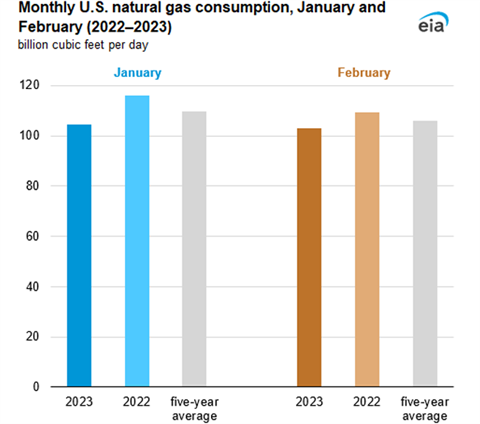U.S. natural gas consumption plunges in January & February
March 23, 2023
 (Graphic: U.S. Energy Information Administration.)
(Graphic: U.S. Energy Information Administration.)
U.S. natural gas consumption in both January and February reached its lowest levels since 2018, according to a recent government survey.
The U.S. Energy Information Administration reported that demand reached an average of 104.4 Bcf/d in January and 103.0 Bcf/d in February 2023. Consumption in January was 10% lower than in January 2022 and 5% lower than the five-year (2018–2022) average for January. February natural gas consumption was 6% lower than in February 2022 and 3% lower than the five-year average for February, the survey shows.
A decline in consumption in the residential and commercial sectors led the overall decline in demand. Consumption was low because of above-average temperatures in those months, particularly in the regions where natural gas consumption makes up a large share of fuel used for space heating.
January 2023 had 22% fewer heating degree days than January 2022 and 16% fewer heating degree days (HDD) than the five-year January average, the EIA reported.
The decrease from January 2022 to January 2023 was greater than usual in part because January 2022 was colder than normal and resulted in 12% more heating degree days than the five-year (2017–2021) January average. Mild weather continued in February this year, leading to 13% fewer HDDs than in February 2022 and 12% fewer HDDs than the five-year February average, the EIA reported.
The warmer temperatures at the beginning of the year led to lower natural gas consumption in the residential and commercial sectors in the U.S. Midwest and Northeast, where natural gas accounts for the highest percentage of heating fuel.
In the Midwest, natural gas consumed in the residential and commercial sectors averaged 10.8 Bcf/d in January 2023 and 10.5 Bcf/d in February 2023, according to data from S&P Global Commodity Insights. The residential and commercial sectors consumed 20% less natural gas in the first two months of 2023 than in the same period in 2022 and 16% less than the five-year average for the two months combined.
Similarly, in the Northeast, natural gas consumed in the residential and commercial sectors averaged 12.7 Bcf/d in January and 12.8 Bcf/d in February 2023. The residential and commercial sectors consumed 23% less natural gas in the first two months of 2023 than in the same period in 2022 and 22% less than the five-year average for the two months combined.
In the West, natural gas consumption in the residential and commercial sectors in January and February 2023 averaged 2% less than in January and February 2022 and 1% less than the five-year average for the two months combined. Although the region experienced one of the coldest winters in years, it relies less on natural gas for space heating than the Midwest and Northeast.
In contrast, changes in weather have a greater affect on electricity generation in the region. Natural gas consumption in the electric power sector was 23% higher in the first two months of this year than in January and February 2022 and 33% higher than the five-year average for the two months combined.
MAGAZINE
NEWSLETTER

CONNECT WITH THE TEAM








